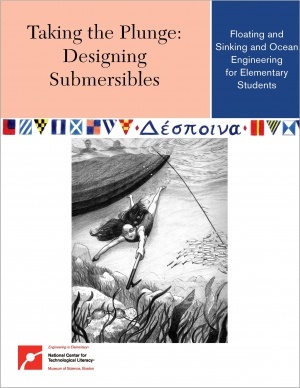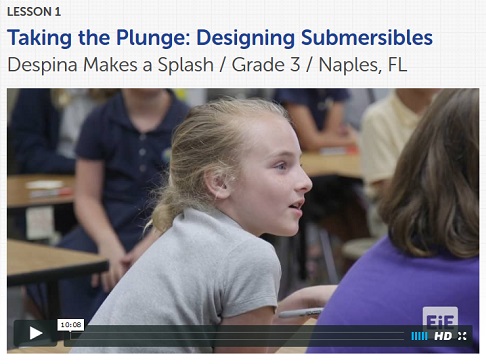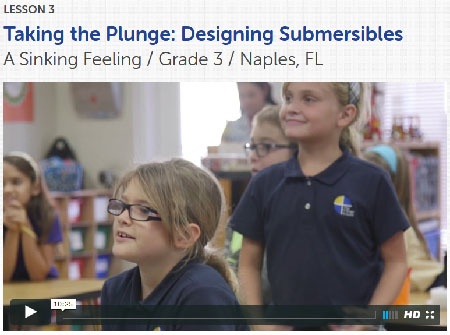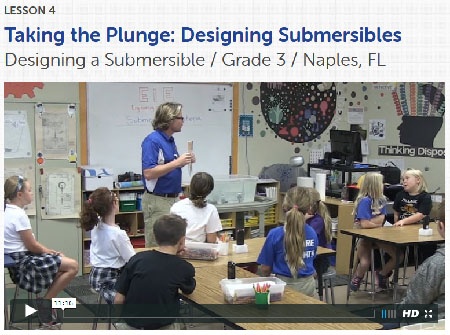 |
For a lively introduction to the Engineering is Elementary unit Taking the Plunge: Designing Submersibles, check out the newest set of Classroom Videos on the EiE website.
Four short videos—one for each lesson in the unit—show an exemplary teacher who keeps students breathlessly engaged as they explore the work of ocean engineers and the science concepts of density, mass, and volume.
Kinesthetic Teaching
You'll visit the classroom of Glen Beitman, a third-grade teacher at The Village School in Naples, Florida. One thing you'll notice in all four videos is how he uses playful interactive facilitation techniques to strengthen students' observation and communication skills. Also notice how he emphasizes kinesthetic learning, inviting students to use hand gestures and full-body movements to express ideas. Here are some highlights from each lesson.
Lesson 1: EiE Storybook
 |
Glen and his students discuss the storybook that sets the context for the engineering design challenge in Lesson 4—it's about a girl in Greece who designs a simple submersible to retrieve her cousin's lost swim goggles from the ocean floor.
The storybook illustrations, projected on a whiteboard, serve as jumping-off points for discussions of geography (the story is set on an island; Florida is a peninsula); diversity (the storybook character, Despina, uses a wheelchair); and what engineers do in their work. Notice how, after posing one question, Glen tells students, "If you are right, give yourselves a round of applause . . . and if you are wrong, give yourselves a round of applause," sending the message that failure helps students learn.
Lesson 2: What Engineers Do in Their Work
 |
This lesson introduces students to an old-fashioned technique for measuring water depth, called a "sounding pole." (Students also learn about modern sonar.) Notice the creative—and dramatic—way Glen demonstrates for students just how little of the ocean floor has been mapped or studied, using a dark room and the "ping" of sonar.
Before students start the mapping exercise (using a cardboard box as a model of the ocean floor), Glen asks them to call out important vocabulary words in unison: "Depth!" "Data!" "Grid!" When the mapping yields unexpected results, Glen turns a glitch into a teachable moment.
Lesson 3: Exploring Materials That Float and Sink
 |
Watch for some great examples of kinesthetic learning in this lesson. As students get ready to test the density of different materials (will they sink or float?), they're up and out of their seats, expressing the concepts of density, mass, and volume with full-body movements.
Glen has a creative way of reinforcing how one word can have two very different meanings; when he uses the term "model," students gesture like high-fashion models; when he uses the term "instrument," they play along on imaginary violins.
Lesson 4: Designing a Submersible
 |
This video focuses on the unit's central engineering design challenge—designing a model submersible. (If you're teaching this unit for the first time, the video is a great way to see how these activities will unfold in your classroom.)
Notice how Glen displays a big poster with the five steps of the Engineering Design Process and directs students' attention to each step as they move through the process. Also notice the questions he poses: "How did you come up with your idea?" and "Why did you change your design?" By the end of the unit, his young students have truly taken a "deep dive" into the field of ocean engineering.
Do you have a creative or novel strategy for teaching an activity from this (or another) EiE unit? Share your story! If we use it on the blog, we'll thank you by sending you the EiE Teacher Guide of your choice.
Engineering is Elementary is a project of the National Center for Technological Literacy at the Museum of Science, Boston









